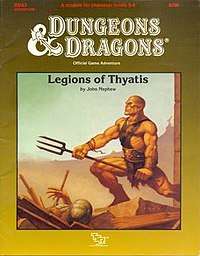Legions of Thyatis
Legions of Thyatis is an adventure module published in 1990 for the Dungeons & Dragons fantasy role-playing game.
 The cover to Legions of Thyatis; artwork by Brom | |
| Code | DDA2 |
|---|---|
| TSR Product Code | 9296 |
| Rules required | Dungeons & Dragons |
| Campaign setting | Mystara |
| Authors | John Nephew |
| First published | 1990 |
| Linked modules | |
| DDA1 DDA2 | |
Plot summary
Legions of Thyatis is a sequel to Arena of Thyatis, and contains a scenario in which the players continue to oppose a corrupt Thatian senator. The players have to venture into a labyrinth of catacombs to prevent the senator from eliminating the wards that protect Thyatis City from the monsters in the subterranean realm beneath it.[1]
Publication history
DDA2 Legions of Thyatis was published by TSR, Inc. in 1990 as a 32-page booklet with an outer folder.[1]
It was written by John Nephew, with a cover by Brom[1] and editing by Jon Pickens.[2]
Reception
Ken Rolston reviewed Legions of Thyatis for Dragon magazine #171 (July 1991).[2] He reviewed Arena of Thyatis and Legions of Thyatis together, and called them "two ambitious and original approaches to low-level D&D adventures", noting gladiators as the theme, and calling the setting "a D&D-game version of ancient Rome".[2] He praised the "open-ended, improvisational role-playing", noting that "the DM is out there all alone with a package of loosely linked episodes, lots of strong NPCs, and myriad plot threads blowing in the wind" without any "hackneyed, predictable plot elements".[2] He did, however, feel that this adventure might not be suitable for most first D&D campaigns, with a first-time DM simultaneously trying to master the mechanics and rhythm of refereeing an FRPG and the subtle dramatic and manipulative techniques of open-ended scenario presentation. He recalled that the module Treasure Hunt, "a much more linear and predictable scenario than these two adventures" has a two-page appendix entitled "If Things Go Wrong", and felt that sort of commentary and advice would be even more critical in open-ended settings like Arena of Thyatis and Legions of Thyatis.[2] He felt that "the ancient Roman city" of Thyatis "doesn't mix comfortably with heroic, D&D-game, action-adventure role-playing", and noted that the impact of spell-casters doesn't seem to have been considered.[2] Rolston concluded the review by stating: "My first response was impatient and unforgiving; only my persistence in trying to appreciate Nephew's good intentions gave me a reserved affection for the most appealing features of these modules. Give them a split grade: four stars for originality, charm, role-playing potential, and right-mindedness, and two stars for quality of DM staging, plot support, and suitability for D&D-game-style play. I do not recommend them for beginning DMs, but as an earnest and moderately successful approach to designing a module for open-ended, improvisational role-playing for the D&D game, they may inspire you to experiment with this difficult but rewarding style of FRPG adventure."[2]
References
- Schick, Lawrence (1991). Heroic Worlds: A History and Guide to Role-Playing Games. Prometheus Books. p. 139. ISBN 0-87975-653-5.
- Rolston, Ken (July 1991). "Role-playing Reviews". Dragon. Lake Geneva, Wisconsin: TSR (#171): 83.